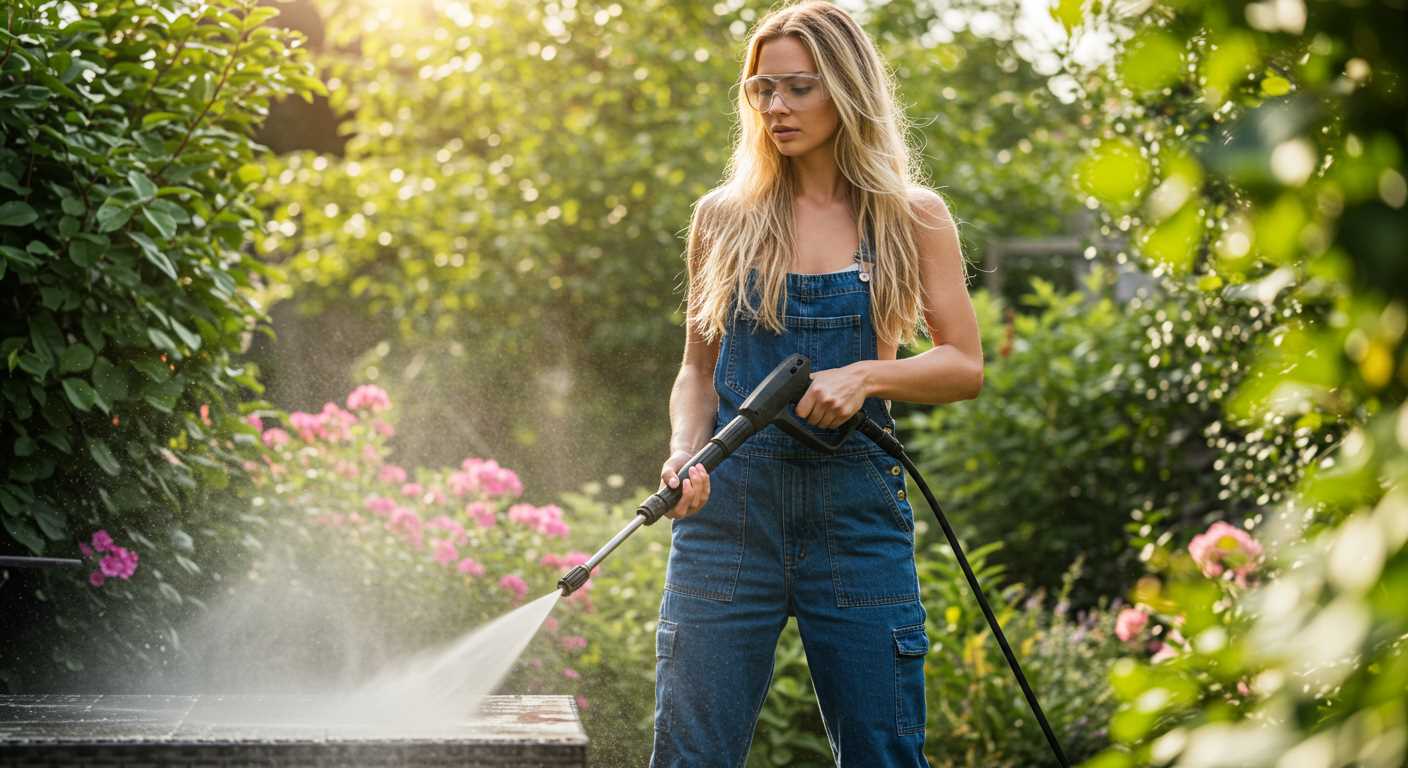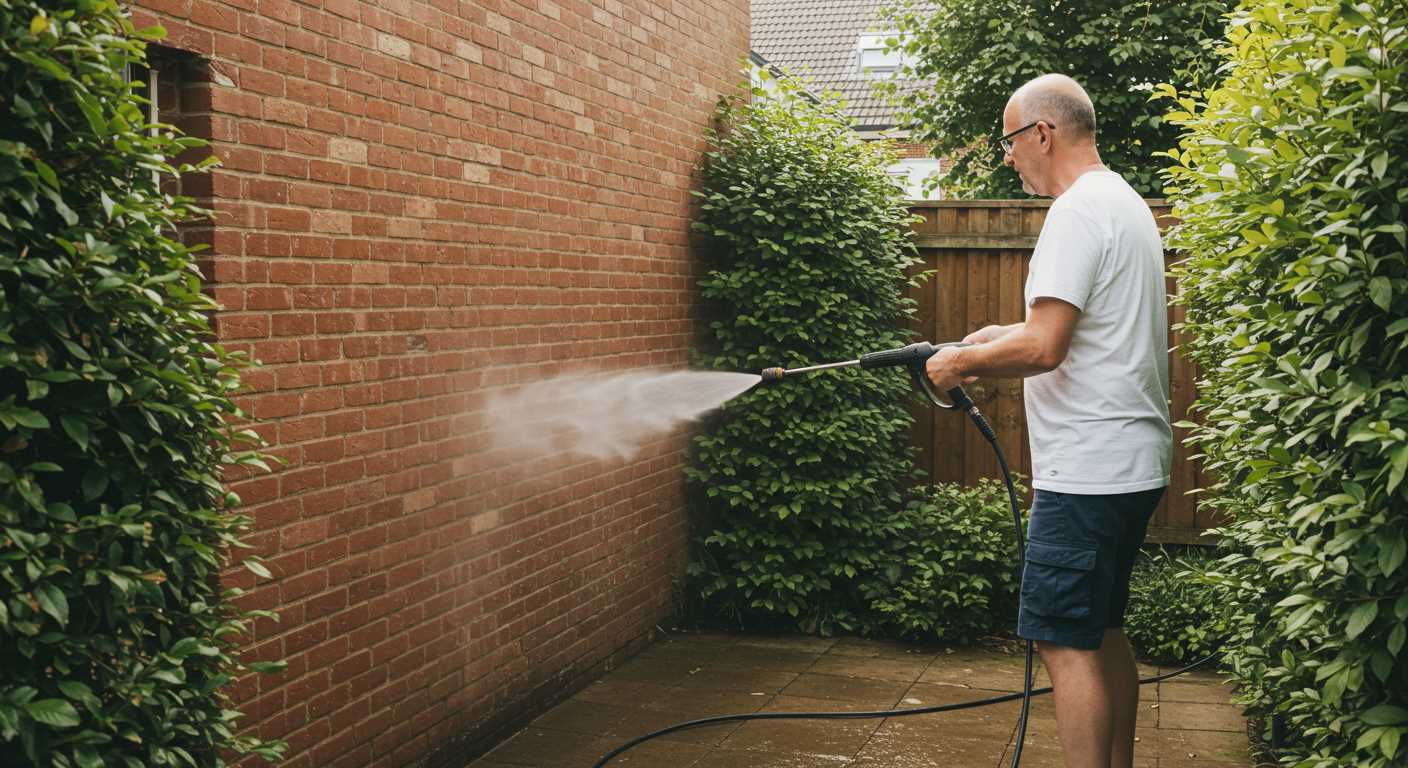



For smaller surfaces like patio furniture and garden tools, an output of 1200 to 1900 PSI is adequate. This level effectively removes dirt without causing damage.
Moving to more robust cleaning, say for driveways and concrete surfaces, aim for a range of 2000 to 3000 PSI. Such power efficiently handles tough grime, grease, and stains that are common in these areas.
For heavy-duty tasks, such as preparing surfaces for painting or removing embedded dirt from brickwork, an output of 3000 PSI or above is necessary. Models in this range provide the muscle needed to tackle the most challenging cleaning jobs while ensuring thorough results.
Always remember, selecting the right output also depends on the surface type; delicate materials like wood require much lower settings compared to harder surfaces like asphalt or metal. Adjust your technique accordingly to prevent damage while achieving the desired cleanliness.
Optimal Levels for a Cleaning Device
The ideal force for an effective cleaning implementation varies by surface type. Use the following benchmarks:
- Concrete: 3000 PSI is effective for heavy stains and oil marks.
- Decks: For wood surfaces, 1300 to 1500 PSI prevents damage while removing dirt.
- Vehicles: Aim for 1200 to 1900 PSI for safe and thorough cleaning without harming paint.
- Siding: 1500 to 2000 PSI is suitable for cleaning various sidings, ensuring dirt and grime removal.
- Patios and Tiles: 2000 to 2500 PSI delivers optimal results for outdoor surfaces.
Adjustable Options
Many units offer adjustable settings, allowing for versatility across different tasks. Lower settings can be applied to fragile surfaces, while more robust levels are perfect for tough jobs. Gradually increase the output to identify the most effective level for each specific application.
Additional Tips

- Always begin cleaning from the top and work downwards to avoid streaks.
- Test in an inconspicuous area before proceeding with wider applications.
- Utilise the appropriate nozzle sizes for varying tasks, as they significantly affect the detachment of dirt.
Understanding Pressure Washer PSI Ratings
The PSI (pounds per square inch) rating is a critical factor that dictates the cleaning capability of a machine. It quantifies the force of water output. For instance, a unit rated at 2000 PSI delivers greater force than one rated at 1500 PSI. Thus, it’s vital to match the PSI rating to the intended task. For light-duty tasks, a rating of 1300-1900 PSI suffices. Moderate cleaning often requires 2000-2800 PSI, while heavy-duty applications, like stripping paint or cleaning concrete, demand 2900 PSI and above.
Types of Tasks and Recommended Ratings

Different surfaces and materials require specific ratings. For washing cars or delicate surfaces, approximately 1200-1900 PSI is ideal. On the other hand, cleaning driveways or patios typically calls for 2500-3000 PSI. Always consider the surface material: softer woods utilise lower ratings, while harder surfaces can withstand higher forces without damage.
Understanding GPM and Their Influence
The GPM (gallons per minute) rating complements the PSI, as it determines the water flow rate. A higher GPM means more water flows through the nozzle, enhancing the cleaning process. For example, a model with 2000 PSI and 2.5 GPM cleans more effectively than one with the same PSI but only 1.5 GPM. Therefore, for optimal performance, balance both ratings and select a machine that suits your specific cleaning needs.
Choosing the Right Pressure for Different Surfaces
For concrete, a setting between 3000-4000 PSI effectively removes grime and stubborn stains. This high output is required to reach the pores of the material where dirt accumulates.
Wood and Decking
For wooden surfaces, particularly decks or furniture, opt for a gentler range of 1200-2300 PSI. Excessive force can scar the wood, causing permanent damage. Additionally, maintain a distance of at least 12 inches from the surface to avoid splintering.
Vehicles and Delicate Surfaces
When cleaning cars or similar vehicles, select a setting around 1500-2000 PSI. This delivers enough cleaning power without risking the paintwork. Using a fan spray tip can further lessen the impact while ensuring even coverage.
Common Applications and Their Required Pressure Levels
For effective cleaning tasks, here are the typical applications paired with their respective psi ratings:
| Application | Recommended PSI Range |
|---|---|
| Concrete Driveways | 3000 – 4000 |
| Wood Decks | 500 – 1500 |
| Vehicles | 1200 – 1900 |
| Siding | 1500 – 3000 |
| Patios | 2000 – 3000 |
| Fencing | 1500 – 2000 |
| External Walls | 2000 – 3000 |
| Roofs | 2500 – 3000 |
Special Considerations
When approaching different surfaces, I recommend adjusting your tool’s nozzle and maintaining a consistent distance from the surface to avoid damage. For instance, electric models typically provide lower output, suitable for light jobs, while gas models excel in heavy-duty applications.
Conclusion
Selecting the correct level of intensity can make a significant difference in the effectiveness and safety of the cleaning process. Adhering to these recommendations will ensure an optimal outcome.
Factors Influencing Pressure Needs: Dirt Types and Conditions
For optimal cleaning, it’s essential to adjust the level of force based on various factors, particularly the variety of grime and environmental circumstances. Here’s how different elements impact the selection process:
- Type of Dirt:
- Light Grime: For dust and light stains, a range of 1000 to 1500 PSI suffices.
- Moderate Stains: Oil or mud may require 1500 to 2500 PSI for effective removal.
- Heavy Soiling: Concrete or graffiti calls for 2500 to 3000 PSI for thorough cleaning.
- Surface Sensitivity:
- Delicate Surfaces: Wood or painted surfaces necessitate lower levels, ideally 1200 to 1500 PSI.
- Durable Surfaces: Brick or concrete can endure higher forces, typically between 2500 to 3000 PSI.
- Weather Conditions:
- Wet Conditions: A higher intensity might be required if the surface is slippery or muddy, as water reduces friction.
- Dry Environments: Dust may require less force, usually around 1000 to 1500 PSI, to remove without scattering particles.
- Age of Stains:
- New Stains: Fresher marks are often easier to clean with lower pressure levels.
- Old Stains: Set stains may require extra force, as well as higher temperatures or cleaning agents for effective removal.
Adapting the intensity to the specific cleaning task enhances the efficiency of your equipment while protecting surfaces from damage. I recommend always testing on a small, inconspicuous area to determine the most effective and safe pressure level for each unique situation.
Comparing Electric vs. Gas Pressure Washers
For residential tasks, electric models typically deliver 1300 to 2000 PSI, making them suitable for light to moderate cleaning, like patios, decks, and vehicles. They’re quieter, lighter, and easier to maintain. They operate with less effort, needing just an outlet and a garden hose. A notable drawback is their limited range due to electrical cords, which can hinder mobility during larger jobs.
Gas-powered alternatives offer a broader range, usually spanning from 2000 to 4000 PSI, which is ideal for tackling heavy-duty tasks such as garage floors, driveways, and industrial equipment. Their mobility is superior due to the absence of cords, permitting extensive usage without proximity to a power source. However, they require more maintenance, including oil changes and winterising, which could deter users looking for low maintenance options.
Performance and Efficiency
My experience shows that gas machines excel in achieving higher PSI quickly, making them effective in reducing time spent on rigorous tasks. In contrast, electric variants are more efficient for light use. They tend to consume less electricity and produce fewer emissions. Depending on the application, one may favour the power efficiency of gas models, while another might opt for the eco-friendliness and ease of electric ones.
Cost Considerations
Electric units generally carry a lower initial investment, making them enticing for budget-conscious consumers. In contrast, gas models entail a higher upfront cost, yet may present better long-term value for those needing high performance for extensive applications. It’s essential to weigh the potential need for power against the budget when making a choice.
Pressure Adjustment Techniques for Optimal Results

For achieving the best outcomes, I recommend starting at a low setting and gradually increasing the intensity based on surface response. It prevents potential damage while ensuring thorough cleaning.
Utilising adjustable nozzles can significantly enhance versatility. A 25-degree nozzle is effective for wide areas, while a 0-degree is perfect for concentrated spots, like stubborn stains.
Additionally, maintaining an appropriate distance from the surface is key. Typically, a distance of around 12 to 24 inches reduces the risk of etching, especially on softer materials such as wood.
In scenarios involving tough grime, employ the detergent feature frequently found in units. Apply detergent from a distance, allowing it to dwell prior to rinse, enhancing removal efficiency.
For delicate surfaces, such as cars or painted siding, adjust settings to the lowest level and use a foam cannon attachment for an even application while minimising risk. Regular checks of surface resilience can help gauge the necessary force.
Observe the variables around, such as type of dirt and surface condition. For smooth surfaces like concrete, a higher setting will yield swift results, whereas porous materials require gentler approaches to avoid damage.
Regular maintenance and correctly filling the unit with water are also essential for optimal performance. Clogs in hoses or nozzles can lead to decreased effectiveness and uneven cleaning.
These techniques aid in maximising performance while minimising risks. Regular assessment of outcomes allows adjustments for future tasks, ensuring even the most challenging cleaning jobs are handled efficiently.
Avoiding Damage: When Less Pressure is More
For many surfaces, opting for lower force can prevent costly mistakes and preserve integrity. For example, using a gentle flow of around 1200 PSI works well on delicate wooden decks and painted surfaces. This level effectively removes dirt without stripping away finishes or damaging the wood itself.
Concrete and Brick Surfaces
When dealing with concrete or brick, I often find that a setting between 1500 and 2000 PSI suffices for effective cleaning. However, one must exercise caution with older, more vulnerable masonry; applying excessive force may erode the surface or chip away at brickwork. Using a fan nozzle can further diffuse the impact on these materials, enhancing its safety.
Automotive Applications
In situations where I’m cleaning vehicles, I’ve learned to stick to a maximum of 1900 PSI. Many automotive finishes can be sensitive to high levels of intensity, risking scratches and damage to seals. Using a wider spray pattern at this setting helps to lift grime without causing harm.
Don’t overlook the importance of distance; maintaining a distance of at least 2 feet from the surface mitigates the risk of damage. This simple adjustment allows me to achieve optimal results while keeping surfaces in pristine condition.
Ultimately, the best approach boils down to balancing effectiveness and safety–sometimes, a lighter touch yields better long-term results. Learning the correct intensity for various cleaning tasks is an investment in both the equipment and the surfaces being worked on.
FAQ:
What is the recommended pressure for cleaning a patio with a pressure washer?
For cleaning a patio, a pressure washer with a rating of around 1300 to 2300 PSI (pounds per square inch) is generally recommended. This range is effective for removing dirt, grime, and stains without damaging the surface. If your patio is made of concrete, a higher pressure may be suitable, but always start with a lower setting and gradually increase it to see what works best.
How do I determine the right pressure for washing my car?
When washing a car, it’s best to use a pressure washer set between 1200 to 1900 PSI. This setting is sufficient for cleaning without risking damage to the paint or delicate components. Additionally, consider using a wide-angle nozzle to create a gentler spray that reduces the risk of scratching the car’s surface. Always avoid direct pressure on windows and sensitive areas.
Is it safe to use a pressure washer on wooden surfaces?
Using a pressure washer on wooden surfaces requires caution. It’s advisable to use a pressure setting of no more than 1500 PSI to prevent damage. Softer wood types, like cedar, can be particularly susceptible to gouging and splintering if the pressure is too high. Opt for a nozzle that provides a wider spray pattern and maintain a safe distance from the surface to achieve effective cleaning.
Can I adjust the pressure on my pressure washer for different tasks?
Yes, many pressure washers come with adjustable settings that allow you to change the pressure based on the task at hand. This feature is especially useful for tackling various surfaces, such as hard concrete versus softer wood. If your model doesn’t have adjustable pressure, different nozzles with varying spray patterns can help regulate the intensity of the water. Always refer to the manufacturer’s guidelines for the best results.
What happens if I use too much pressure while washing?
If too much pressure is applied while washing surfaces, there is a risk of causing damage. High pressure can strip paint, etch concrete, and even cause injury if directed towards people or animals. For delicate surfaces like vehicles or wooden decks, the wrong pressure can lead to costly repairs. It’s crucial to find the right balance to achieve effective cleaning while avoiding harm to both the surface and yourself.










